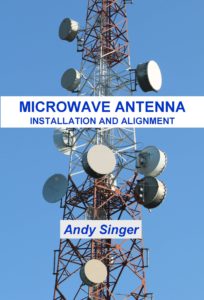Microwave antennas are a critical element of any microwave network and in this post we will examine some basic microwave antenna types. Many microwave antenna types are available to meet various electrical and mechanical requirements. The most commonly utilized antenna for terrestrial microwave networks is the parabolic. Other types of antennas that are less frequently used for microwave networks include sector, flat panel, Yagi, horn and dielectric lens antennas. Each type has characteristics that make it most suitable for specific systems and situations. The following sections will discuss these various types of microwave antennas.
Standard Parabolic
There are two main types of parabolic antennas, standard performance and high performance. Standard microwave parabolic antennas, or “dishes,” consist of a parabolic shaped reflector, typically spun from a sheet of aluminum (1/8” – 3/16” thick) depending on the size of the antenna. On larger size antennas the rim is often rolled for added structural strength. This parabolic shape focuses energy at the feed point (what is referred to as the focal point of the antenna) and assures a constant phase front at the aperture. The signal is focused in a relatively narrow beam. Due to this relatively narrow beamwidth, they have a relatively high gain, compared to many other types of antennas. The gain of the parabolic antenna depends on its size, or aperture, and the frequency of operation. This assumes a smooth reflecting surface, as any surface irregularities can greatly impact the gain. Parabolic microwave antennas are most commonly available in sizes from 1 foot to 12 feet in diameter. The manufacturer typically includes a pipe mount kit that allows mounting to a minimum 4 inch vertical pipe (4.5 inch O.D.). They can be a good option where a high degree of F/B ratio and side lobe suppression is not required. Due to the potential for interference in crowded microwave spectrum, most government regulations require the greater suppression provided by high performance antennas for licensed microwave bands.
High Performance
High performance parabolic antennas, often noted as just HP, utilize a shroud to improve side lobe performance and the antenna’s front-to-back ratio. The shroud is sometimes referred to as a “drum” or “shield” due to its physical attributes. The shroud is often lined internally with absorber material, which is carefully designed low density foam that utilizes carbon or other “lossy” material to absorb specific RF frequency signals and minimize reflections. The high performance design reduces side lobes allowing antennas to meet more stringent pattern requirements for reducing interference. High performance antennas do not have higher gain than standard performance antennas, which seems to be a not uncommon misunderstanding. If anything, they probably have a few tenths of a dB less gain due to the shroud and absorber. This subtle difference in gain is hard to measure accurately and sometimes ignored in specifications. High performance antennas cost more than standard performance antennas, due to the extra material and labor involved with their production. However, their better pattern performance is often required for operation in licensed microwave bands and is useful in unlicensed bands, such as 5 GHz, that are crowded with potential interferers.
Ultra High Performance/Special Designs
Beyond the high performance style microwave antenna, there are other specialized designs, such as the ultra high performance antenna, also called the super high performance. With the ultra high performance antenna modifications are made to the antenna and feed system to provide slightly better pattern performance. Often this involves more absorber material, which improves side lobe performance relative to the high performance antenna. These antennas may be required in congested areas where link density is high, in order for the link to be successfully coordinated. If you license enough links, eventually the company that performs your frequency coordination may require the use of one of these antennas, in lieu of a high performance antenna, in order to properly coordinate and license a proposed link. There are also specialized antennas that meet ETSI Class 4 requirements. These antennas have lower side lobes than Class 3 antennas, that may help reduce the chance of interference and provide for better frequency reuse.
There are also specially engineered versions of high performance parabolic antennas that are designed such that a radio ODU (outdoor unit) can directly mount to the back of the antenna. This eliminates the need for waveguide and greatly reduces system cost. These antennas are typically referred to as integrated or slip-fit antenna designs. We will discuss slip-fit design antennas further in the next chapter.
Hub/Sector
Sector antennas, sometimes called hub antennas, are designed to provide a segmented coverage pattern over a selected area. They are the most common type of antenna utilized for cellular communication systems and for fixed wireless access networks such as ISM, WLL and WAN systems. Sector antennas deliver a wider beamwidth than parabolic point-to-point antennas, with a corresponding lower gain, due to the wider beamwidth. The most common horizontal beamwidth sectors deployed are 60, 90 and 120 degrees. Sector antennas, as well as panel antennas, can vary greatly in their ability to meet advertised gain specifications at microwave frequencies. This point will be discussed further in the next chapter on selecting microwave antennas. Another special application sector antenna is millimeter microwave sector antennas for point-to-multipoint system hub antennas, in frequency bands such as 28 GHz, 31 GHz and 39 GHz. In the United States there bands are known as LMDS – Local Multipoint Distribution Service. LMDS uses a cellular style infrastructure with multiple base stations and small customer transceivers able to return communications. Distance between sites is typically less than five miles and small parabolic dishes are normally used on the customer access side of the microwave link. These millimeter wave bands are also being considered for extensive usage as part of the future cellular 5G standards. This is due to the expected capacity and speed requirements of 5G systems and the relatively large available bandwidth in these higher frequency bands. As of the writing of this book, Facebook had demonstrated links operating at 36 Gbps capacity on a terrestrial millimeter wave point-to-point link.
Flat Panel
Flat panel antennas are square shaped antennas that can be packaged in a relatively low profile radome. Figure 2.3 is a picture of a typical flat panel antenna. Due to their visual appeal and ease of concealment, they are utilized when aesthetics are critical. They are generally available for most popular broadband wireless bands such as the 2.4, 3.5 and 5 GHz bands. They are almost always designed using some type of relatively “low cost” PC board material. The higher the frequency band, the more loss present in these materials and the less likely it is that they can achieve the expected gain for their aperture size. As antenna efficiency decreases, more energy is absorbed traveling on the surface of the PC board material and less energy is radiated by the antenna. This leads to less gain being achieved for a given size antenna, as frequency is increased. Flat panels can be a very useful tool at UHF frequencies, but their application may be limited as the frequency of operation moves into the microwave frequency bands. At microwave frequencies a well-designed parabolic dish, will always have higher gain than an equivalent sized flat panel antenna. The antenna patterns are also more likely to be consistent from unit to unit, with a parabolic dish. The author once had the opportunity to observe the gain measurement of a 38 GHz flat panel antenna, that was being offered commercially for terrestrial microwave systems. The gain, as expected, was several dB less than achievable with the same size parabolic dish. The gain was also several dB less than was advertised by the company marketing the antenna. Eventually there might be active arrays at commercially affordable prices that resolve this gain issue for flat panel antennas at microwave frequencies. Until that time, their usefulness is limited to below 5 GHz. Flat panels are available from numerous sources and can easily be “disguised” to match the building they are mounted on using the appropriate type of paint, to camouflage the antenna.
While flat panel antennas are not optimal for point-to-point microwave networks, they can be useful for some applications in the microwave frequency range. There are micro-strip patch antennas that have an ideal profile for some of these other applications. A micro-strip patch antenna consists of radiating patch that is bonded to a dielectric substrate on one side and has a ground plane on the other. The patch is typically composed a highly conductive metals, such as copper. They have a low profile and are very lightweight. However, just like with other panel type antennas, the gain is limited due to transmission line losses as more elements are arrayed. Micro-strip patch antennas can be useful for antennas in cell phones, GPS devices and defense applications such as airborne arrays and satellite communication. The successful design of these antennas requires understanding mutual coupling between the radiating elements and developing the techniques to achieve the desired specifications.
Yagi
The Yagi antenna is a versatile antenna that uses a driven element, with a reflector behind the driven element and a director, or series of directors, in front of the driven element. The Yagi, which should really be called a Yagi-Uda antenna after the inventors, is a useful directive antenna in the HF, VHF and UHF bands. The Yagi was invented by H. Yagi and S. Uda of Tohoku University in 1926. A Yagi utilizes relatively easy construction techniques to provide reasonable gain, up to about 2 GHz. Their ease of construction and lightweight makes them useful for lower frequency point-to-point systems.
With a Yagi, the reflector element is slightly longer than the driven element and the driven element is about a half-wavelength long. The director, or directors if more than one are in front of the driven element, are slightly shorter. While the gain of a Yagi antenna increase with the number of directors, there is a “diminishing return” for the antenna’s gain as a larger number of directors is added. It is also possible to “stack” multiple Yagis for more gain. Yagi antenna design has become significantly easier to optimize for characteristics such as gain, front-to-back ratio and bandwidth, with the modern antenna design software that is available. Some designs utilize a corner reflector behind the driven element to improve performance.
Our founder has designed, built and utilized Yagi-Uda antennas successfully for frequency bands from 14 MHz to 1900 MHz. This includes both personal and commercial projects. The front-to-back ratio of the Yagi is limited to perhaps 20 dB to 25 dB over a relatively narrow bandwidth. Their ease of construction makes them an excellent choice when an antenna is needed quickly for a directional application in the VHF and UHF bands, and even the HF bands, if enough material is available.
Horn
A horn antenna, sometimes called a microwave horn, is basically a flared waveguide feed which has a shape that resembles a horn. This horn shape provides a transition between waveguide feed and the launch into free space at the horn opening. The signal is launched in the waveguide portion of the horn using a short probe. Horn antennas have been used for over 100 years and are used for a number of special applications at microwave frequencies.
Horn antennas provide a very efficient way to transfer energy from a waveguide opening into free space, at the flared end of the horn. The waveguide feed serves to set a minimum frequency, as the waveguide will not support RF below a certain frequency range. Smooth wall horn antennas have a very broad frequency range, with a 10:1 bandwidth not being uncommon. Corrugated horns have corrugations, which are slots or grooves (small compared to the wavelength) along the inside surface. They offer improved side lobe performance over the range they operate at,. This is because the corrugations change the field patterns so as to provide the desirable proprieties of axial beam symmetry, low side lobes and low cross polarization. There are a growing number of applications using millimeter waves which utilize corrugated horns as either discrete antennas, or as a feed for reflector antennas. They have been successfully designed and deployed at frequencies above 100 GHz. A bandwidth of 10% or greater is easy to achieve with corrugated horns and techniques are available to develop antennas with much greater bandwidth.
Horn antennas typically have a gain of about 10 to 20 dBi, depending on the size and frequency utilized. The larger the horn, or the higher the frequency, the more gain supported and the narrower the beamwidth. This is because the higher the frequency of operation, the larger the horn appears electrically. There are also sectoral horns. These horn antennas are only flared on one pair of sides. This configuration produces a fan-shaped beam, which is narrow in the plane of the flared sides, but wide in the plane for the narrow sides.
Horn antennas are useful for certain microwave and millimeter wave applications due to their wide bandwidth, low side lobes, ease of construction and relative ease of interfacing to waveguide. They are extensively utilized at microwave frequencies when the power gain required is moderate. Common uses include standard gain “calibration” horns for use on antenna ranges, feeds for parabolic antennas, radar gun antennas and sector antennas requiring very good side lobe performance. They have been utilized successfully as sector antennas in millimeter wave point-to-multipoint networks, in services such as LMDS (Local Multipoint Distribution Service) applications.
Dielectric Lens
While not well-known, or utilized currently for terrestrial microwave systems, dielectric lens antennas have properties that could make them useful for upcoming 5G millimeter wave band spectrum networks. As these antennas represent a potentially useful tool for upcoming future short range, high capacity networks, they will be briefly introduced and discussed. Lens and parabolic reflectors both perform the same basic function – modification of phase. The shape of the lens is designed to produce a constant phase front at the output aperture. Dielectric lenses can be made from relatively soft thermoplastics, such as Lucite, polystyrene, Plexiglas or Teflon and can be easily machined using typical machine-shop methods or molded. Lens fabrication involves locating dielectric materials with the appropriate electrical properties (dielectric constant and loss tangent) as well as the proper mechanical characteristics compatible with the milling process. Dielectric lens antennas can also be made from material with a very high refractive index, to reduce their size, such as titanium dioxide. Dielectric lenses can produce highly shaped beams over large operating bandwidths. Designs are easily capable of achieving a 10% bandwidth. In millimeter wave applications where required gain values are not high, lenses can be an attractive option relative to reflectors due to their small size, relative ease of machining and because the feed lies behind the lens, unlike parabolic antennas where the feed can potentially disturb the radiation patterns. Another possibility is to design a lens-corrected horn, which would create a compact high-performance feed for certain reflector antennas.
Summary
The microwave system engineer designing a network must review the various trade-offs in determining which type of antenna, or antennas are best, depending on specific requirements. For point-to-point terrestrial microwave links this is typically parabolic antennas. For other applications size, aesthetics, or other factors, may be more important. Certainly network design in the millimeter wave band will incorporate other types of antennas such as corrugated horns or dielectric lens antennas. To learn more about microwave antennas, consider one of our technical training classes, or purchase a copy of Andy Singer’s microwave antenna book – Microwave Antenna Installation & Alignment. Learn more about this excellent book on this page Microwave Antenna Book.



